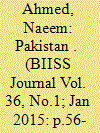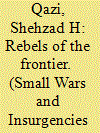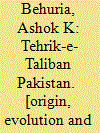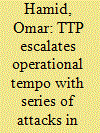|
|
|
Sort Order |
|
|
|
Items / Page
|
|
|
|
|
|
|
| Srl | Item |
| 1 |
ID:
115485


|
|
|
| 2 |
ID:
140306


|
|
|
|
|
| Summary/Abstract |
This paper critically examines the counterterrorism strategy of Pakistan, which it adopted after the 9/11 incident, by arguing that so far, it has proved ineffective and counter-productive in uprooting the terrorist network of Pakistan-based militant Jihadi and extremist groups that also have links with Al-Qaeda. In this respect, the paper, besides defining and assessing Pakistan’s counterterrorism strategy, also analyses various factors which have contributed to the inefficacy of the country’s counterterrorism strategy. In the concluding analysis, the paper emphasises upon the need for formulating an effective counterterrorism strategy of Pakistan.
|
|
|
|
|
|
|
|
|
|
|
|
|
|
|
|
| 3 |
ID:
112211


|
|
|
| 4 |
ID:
107898


|
|
|
|
|
| Publication |
2011.
|
| Summary/Abstract |
The Pakistani Taliban, factionalized into some 40 groups, form a decentralized insurgent movement, often characterized by infighting, divergent motivations, and a shifting web of alliances. The Pakistani Taliban remain little understood because most scholars have avoided a serious treatment of the insurgent movement and instead focused on analyzing the geopolitics of the region and Pakistan's 'double game'. This article seeks to fill this gap by dissecting the movement through selected theories of organization and mobilization. First, I explain the various dimensions of the conflict and the origins of the insurgency. Next, I discuss the Pakistani Taliban's political organization, categorizing it as composed of various warlord regimes. I further list the Taliban's component groups and numerical strength and chart the leadership structure. Lastly, I analyze insurgent recruitment strategies, accounting for the role of selective incentives, coercion, and genuine grievances.
|
|
|
|
|
|
|
|
|
|
|
|
|
|
|
|
| 5 |
ID:
179820


|
|
|
|
|
| Publication |
New Delhi, KW Publishers Pvt Ltd, 2021.
|
| Description |
xix, 203p.hbk
|
| Standard Number |
9789391490027
|
|
|
|
|
|
|
|
|
|
|
|
Copies: C:2/I:0,R:0,Q:0
Circulation
| Accession# | Call# | Current Location | Status | Policy | Location |
| 060041 | 303.625/BEH 060041 | Main | On Shelf | General | |
| 060042 | 303.625/BEH 060042 | Main | On Shelf | General | |
|
|
|
|
| 6 |
ID:
131878


|
|
|
| 7 |
ID:
163359


|
|
|
|
|
| Summary/Abstract |
MANY GROUPS ASPIRE TO GOVERN TERRITORY, but few actually followed through with it to the extent that the Islamic State in Iraq and Syria (ISIS) had. In addition to the brutal executions and disfigurements, ISIS also came to be known for fixing potholes, installing power lines, administering polio vaccines, and establishing schools, post offices, roving police forces, food kitchens, and even a consumer protection bureau.
Welfare was an important component of ISIS's “stateness”2 and was widely viewed as a means by which the organization targeted the hearts and minds of the local population. However, not all militias with territorial aspirations provide public goods. Tehrik‐e‐Taliban Pakistan (TTP) is a case in point. The TTP is the largest jihadi group operating in Pakistan, with the ultimate goal of installing a caliphate. While active mainly in a region where state provision of social services is poorest, the TTP has shown little regard for its inhabitants’ welfare. Surprisingly little of the militia's inordinate wealth has been allotted to taking care of the local population. Why do some militias provide welfare while others do not?
|
|
|
|
|
|
|
|
|
|
|
|
|
|
|
|
|
|
|
|
|